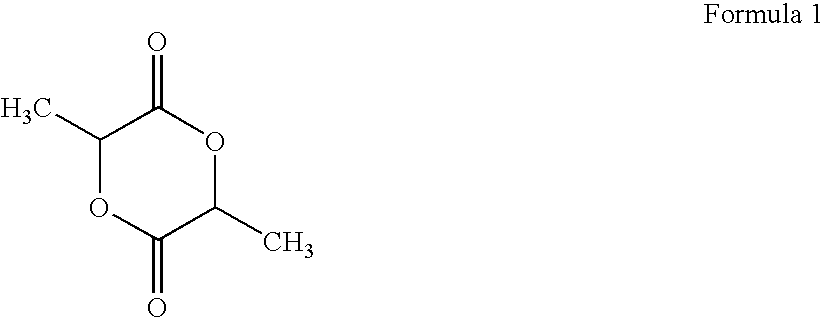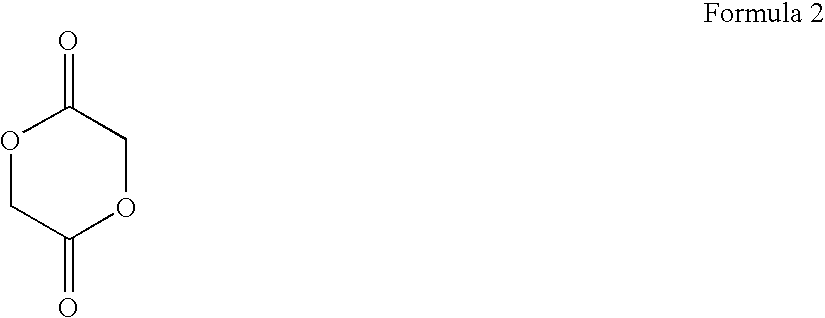Biodegradable Modified Caprolactone Polymers for Fabricating and Coating Medical Devices
- Summary
- Abstract
- Description
- Claims
- Application Information
AI Technical Summary
Benefits of technology
Problems solved by technology
Method used
Image
Examples
example 1
[0066] In Example 1 the synthesis of a modified caprolactone monomer is described, specifically 4-tert-butyl caprolactone.
[0067] To a cooled (0C.) solution of 4-tert-butyl cyclohexanone (50.0 g, 0.324 mol) in dichloromethane (100 mL) is slowly added 3-chloroperbenzoic acid (90.0 g, 0.365 mol, purity of 70%) in dichloromethane (450 mL). After the reaction is complete the mixture is filtered and is first washed with sodium thiosulfate (15% wt / v, 2×200 mL) and second with sodium bicarbonate (saturated, 5×200 mL). The organic solution is dried with sodium sulfate and filtered. The solvent is removed in vacuo and resulting material purified by vacuum distillation (collected: 118-124° C. at 0.08 torr) to yield a solid material (70%) with a melting point range of 49-51° C.
example 2
[0068] In Example 2 the synthesis of modified caprolactone copolymers is described, specifically copolymers comprising 4-tert-butyl caprolactone and lactide. A general procedure follows.
[0069] To a mixture of tin octoate, 4-tert-butyl caprolactone is added 1,8 octanediol and lactide. The atmosphere of the reaction chamber is subjected to five vacuum / argon cycles The mixture is then heated (125° C.) for 72 hours. The resulting polymers are precipitated from methanol and chloroform solutions.
TABLE 1Formulations for Example 2.PolymerTin4-tert-butylLactideNo.Octoate (g)1,8 Octanediol (g)caprolactone (g)(g)10.02030.00611.60006.400020.01920.00683.20004.800030.02080.00604.80003.200040.01900.00606.40001.6000
[0070]
TABLE 2Properties of Formulations for Example 2.4-tert-butyl caprolactonePolymer No.(mol %)MnMwTg (° C.)18.0510694717321235.9216.818178237618925.2336.411670422006012.3461.5811201723223.9
example 3
[0071] In Example 3 the synthesis of a modified caprolactone monomer is described , specifically a cyclohexyl fused caprolactone.
[0072] To a cooled (0° C.) solution of 2-decalone (50.0 g, 0.328 mol) in dichloromethane (100 mL) is slowly added 3-chloroperbenzoic acid (90.0 g, 0.365 mol, purity of 70%) in dichloromethane (450 mL). After the reaction is complete the mixture is filtered and is first washed with sodium thiosulfate (15% wt / v, 2×200 mL) and second with sodium bicarbonate (saturated, 5×200 mL). The organic solution is dried with sodium sulfate and filtered. The solvent is removed in vacuo to present the cyclohexyl caprolactone.
PUM
| Property | Measurement | Unit |
|---|---|---|
| Temperature | aaaaa | aaaaa |
| Temperature | aaaaa | aaaaa |
| Temperature | aaaaa | aaaaa |
Abstract
Description
Claims
Application Information
 Login to View More
Login to View More - R&D
- Intellectual Property
- Life Sciences
- Materials
- Tech Scout
- Unparalleled Data Quality
- Higher Quality Content
- 60% Fewer Hallucinations
Browse by: Latest US Patents, China's latest patents, Technical Efficacy Thesaurus, Application Domain, Technology Topic, Popular Technical Reports.
© 2025 PatSnap. All rights reserved.Legal|Privacy policy|Modern Slavery Act Transparency Statement|Sitemap|About US| Contact US: help@patsnap.com



